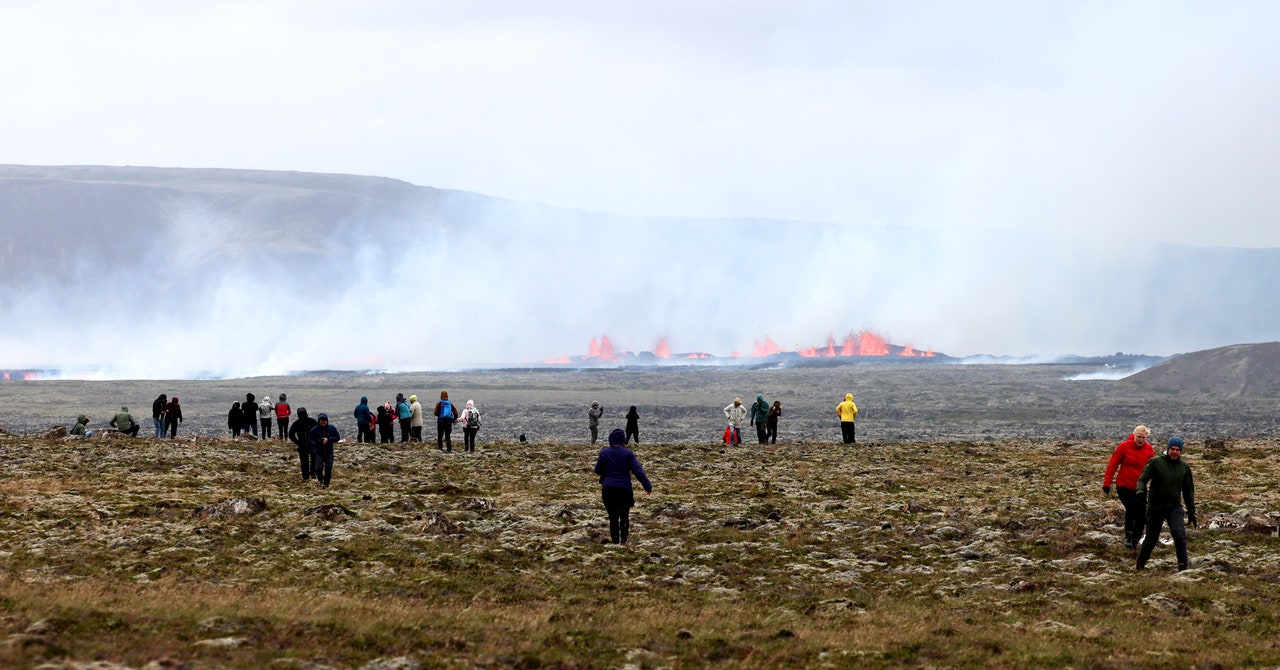my first day in Iceland last August was clear and sunny, a vacationer’s dream. And it turned out to be a great day to take advantage of a tourist activity I hadn’t originally signed up for: flying over the Reykjanes Peninsula by helicopter for a top-down view of an asset. volcanic eruptionspecifically Sundhnúksgígar.
Ryan Connolly of hidden icelanda tour company that helped me organize my trip suggested the last minute helicopter ride because a volcano on the southwestern tip of the island had recently been active. Not wanting to miss out, I paid for the helicopter tour from my phone at 1pm after arriving in Iceland at 6:15 that morning. After a short nap at the hotel, I drove two hours to the meeting point, which is 10 minutes from Reykjavík city, for a 7pm flight that evening.
The helicopter had six people in total, including the pilot, with little room for movement. Based on the height and weight of myself and my fellow passengers, I strategically placed myself at the rear right of the helicopter. The cabin had floor to ceiling glass windows so we could enjoy the full view of the landscape. We all put on headsets equipped with microphones, the only way to communicate with each other through the noise of the helicopter blades.
A few minutes after takeoff, the pilot described the sights below, which at first included the city, but soon became a vast, empty, black land. As the helicopter descended to the right, the erupting volcano came into view with magma rising and erupting red and orange, a stark contrast to the black earth. We could see the magma seeping down the side, getting thinner and softer as it moved away from the slope. The pilot circled the volcano a few times so the left and right passengers got a good look before flying to a nearby dormant volcano and telling their story.
Safety rules
Jón Grétar Sigurðsson, owner of Atlantsflugthe helicopter tour company I used explains that planning such flights has become standard since eruptions have become more common. “We fly according to aviation regulations. Normally, when an eruption starts, the area is closed to everyone. But now the Icelandic government has established certain flight paths that we follow and certain procedures, (including) distances of how close we can get and at what altitude we must stay”.
When I arrived that night, the flight ahead of me had been delayed. So I waited in the office with the other guests where we chatted, drank coffee and watched a live stream of the volcano.
There are generally two main reasons why a flight can be delayed or cancelled. “Sometimes the area is closed to all operations because the government is taking some measures,” says Sigurðsson. “Something that can happen without much warning. Weather can also be a factor, especially in winter. If there’s a delay on the first flight or two, we’ve usually picked it up on the third flight to re-hire.”
How they control volcanic activity
According to Sigurðsson, Iceland’s government is aware of the volcanic activity and is constantly monitoring it. “It’s like a patient with constant care in the hospital,” he says. “I would say they’re measuring very broadly and looking at the uplift of the ground in millimeters. On the graph, we see when the eruption started and then the ground sinks back in. As the eruption continues, and it starts to rise from new, we know magma is building up in the same chamber, it was showing the pilot this morning that there is a definite increase in elevation in the area, and it’s a duplicate of what happened the last time.”
Volcanic eruptions are common in Iceland and something Sigurðsson says they can expect over the next 30 to 100 years.
My helicopter ride that August night lasted about 40 minutes, with all six circling the volcano from the left side to the right side and back again. Smoke was coming out, but it was heading in the opposite direction of our flight pattern, giving us a clear view of the volcano. As the pilot took us to the airport, I could see the ground getting more populated before we descended towards the earth. A soft landing sent me crashing to the ground and I headed to my hotel that night glad I was in the right place at the right time.
Note: Since this article was written, there has been another eruption in a similar location. According to Hidden Iceland’s Connolly, it remains “business as usual for international flights, main roads, local infrastructure and travel anywhere other than the site of the eruption, which includes Grindavík and the Blue Lagoon.” At the moment, the only safe way to see the volcano is by helicopter.





